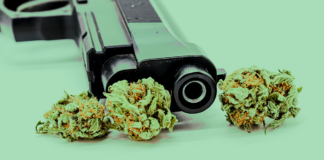
The widely successful efforts to legalize and decriminalize cannabis have dramatically shifted the conversation on the drug. Emphasizing cannabis’ myriad health and wellness benefits as well as the historical harms and injustices of criminalization, those efforts have downplayed the drug’s potential risks. But for the same reasons that researchers have only a vague understanding of cannabis’ medicinal effects, their knowledge about what contributes to cannabis misuse and abuse, and how, is also limited.
With instances of cannabis use disorder (CUD) on the rise, researches say understanding cannabis dependency and addiction is just as important as understanding how to best use it as medicine. And a new study in the journal of Drug and Alcohol Dependence is delving into the causes and consequences of the recent rise in CUD.
Nine Percent of Cannabis Users Will Develop a Dependency
Cannabis is much less addictive than drugs like heroin or cocaine. Only an estimated nine percent of cannabis consumers will develop a dependence on it. Compare that to heroin, which hooks about 25 percent of its users. But the rate of cannabis use is much, much higher than heroin or other hard drugs. So that nine percent actually impacts a far greater number of people.
Because there is no known lethal dose of cannabis for humans, and because physical symptoms of withdrawal are slight—hardly the gut-punishing agony of coming off the hard stuff—the popular perception is that marijuana addiction doesn’t exist. But the science says otherwise. Psychologists, psychiatrists, and neuroscientists have all identified symptoms of cannabis dependency and addiction. They say CUD has three symptoms—the “Three Cs”. First, there’s loss of control over one’s use. Second, there’s compulsivity of use. And finally, harmful consequences of use.
Researchers also distinguish between cannabis dependency and addiction. Dependence is a physical condition. A cannabis consumer develops a tolerance and experiences withdrawal if they suddenly stop. Addiction, on the other hand, is a psychological phenomenon, an experience of a loss of control. Dependence and addiction often overlap, but they don’t have to.
Researchers Identify Complex Causes Behind Cannabis Use Disorder
For researchers, cannabis use disorder is any combination of addiction and dependence on the drug. And CUD is on the rise, but researchers don’t have a clear understanding of why. One of the most compelling conclusions to come out of the new study, however, suggests that cannabis’ ever-increasing potency is a major factor.
According to the study, a person’s first dose of THC can significantly influence their risk of developing symptoms of CUD. For example, if a person’s first experience with cannabis is with a product containing 12 percent THC or higher, they are more than four times at risk of developing CUD symptoms within the first year.
But addiction and dependence are about more than just the substance. If it were that simple, every cannabis consumer would have problems with CUD. That’s why the new study focused on the impact of pre-existing mental disorders. “The risk of addiction is really less about the drug and more about the person,” says Itai Danovitch, chair of the Department of Psychiatry and Behavioral Neurosciences at Cedars-Sinai. It’s also about social and environmental context. In an effort to overcome decades of anti-scientific ideas about cannabis, the drug’s real risks have taken a back seat to evidence of its many benefits, especially in public policy discussions.
Psychologists Target Early Intervention to Prevent Cannabis Use Disorder in Teens
As a result, young people especially are growing up in a world where the dominant stance on cannabis is shifting. And the knowledge that cannabis is less risky than many other common substances may be contributing to the sense that it’s relatively risk-free. But during adolescence, a period of intense brain development, a person is even more susceptible to developing symptoms of CUD.
That’s why scientists and health professionals are calling for more early intervention programs to prevent teens from developing dependencies on cannabis and other substances. If the risk of addiction really is more about the person, then young adults are people whose developing brains make them more vulnerable to use disorders.
Other groups, like the National Organization for the Reform of Marijuana Laws (NORML), are calling for new rules to better identify the risks of cannabis. NORML deputy director Paul Armentano says regulation, not prohibition, can best mitigate the potential risks of CUD.











